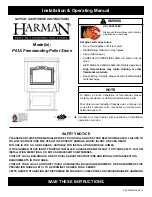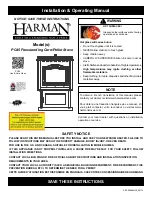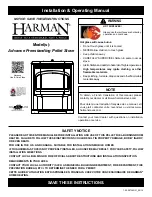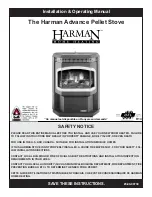
33
6
USE
STÛV 16-CUBE & 16-H
It is essential to use
dry wood
that has a moisture content of
less than 18%
. This will
ensure
more efficient
and
clean combustion
.
Using
wet or semi-dry wood
with a moisture content
higher than 18%
will result in
mediocre and less efficient combustion. The fire will be smaller and difficult to start.
It will release a great deal of
black smoke
and
pollution
into the air and also sully
your glass pane and chimney pipe.
To choose dry wood, use a moisture meter or check if...
• The wood is lightweight and slightly split
• You hear a snap when banging one log against the other
• The bark comes off easily
• There are cracks from the centre to the edge
The harder a wood is, the more heat it will produce and the slower it will burn (at
equivalent moisture content).
Softwood can be used as kindling over hardwood. It burns more quickly (at
equivalent moisture content) despite its lower calorific value.
• Hardwood:
oak, beech, elm, ash, acacia, hornbeam, maple
• Fruit tree wood:
walnut, cherry, pear, apple, olive
• Softwood:
poplar, birch, linden., locust, chestnut
• Resinous wood:
maritime pine, spruce, Scots pine, fir, larch
Ash and beech
are recommended as firewood as they dry quickly and are easy
to find. They must be stored under a shelter immediately after being cut and split,
otherwise they rot very quickly and lose their calorific value. They are easy to light
and produce very bright, lively flames.
Maple
has a good calorific value. It produces fires and embers that last a long time.
Oak
is an excellent fuel, but unlike other wood species, it has to remain uncovered for
two years to allow the rain to remove the tannins it contains. Then it has to be stored
under shelter for another year or two before it can be burned. Small oak branches
have a high sapwood content, which burns too quickly. Oak burns slowly, produces
a calm fire and beautiful embers. It is ideal for barbecuing and for moderate fires.
Hornbeam, cherry and fruit trees
are excellent fuels, but are rare. These are
hardwoods. They produce beautiful, harmonious and calm flames, and beautiful
embers. Ideal for a barbecue or a calm fire.
Birch, linden, chestnut, poplar and black locust
are broad-leaved trees with
soft wood. They produce beautiful, harmonious, but bright flames and few embers.
Because they burn quickly, they can be used to start (or restart) the fire. Caution:
Poplar produces abundant and volatile ash while black locust produces significant
sparks.
Resinous woods (not recommended)
generate a lot of heat, but they burn quickly.
They throw sparks and the resins they contain cause build-up in the chimney.
Each type of wood has a different calorific value and all burn in different ways.
We strongly encourage the use of hardwoods
such as hornbeam, maple, oak, ash,
elm and beech. They produce beautiful flames and plenty of embers that glow for
a long time.
HUMIDITY LEVEL
WOOD TYPES
HARDWOOD OR SOFTWOOD
CALORIFIC VALUE
Humidity level
Wood types
Calorific value
Hardwood or
softwood
.1
FUEL SELECTION
Summary of Contents for 16-cube Series
Page 8: ...2 COMPONENTS 2 1 LIST OF COMPONENTS 9 2 2 AIR INTAKE ACCESSORIES 11...
Page 29: ...5 1 DIMENSIONS AND CERTIFICATION 30 5 2 TYPICAL INSTALLATION 31 5 CHIMNEY...
Page 43: ...E X T E N SION DE GAR A N T I E 8 1 WARRANTY DETAILS 41 8 2 WARRANTY FORM 42 8 WARRANTY...
Page 46: ...46 NOTES ST V 16 CUBE 16 H...
Page 47: ...47 NOTES ST V 16 CUBE 16 H...
















































